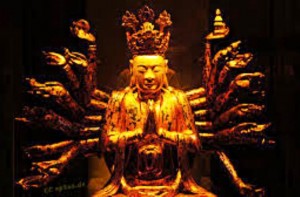 By: Krissy Pozatek / Source: Mind Body Green
By: Krissy Pozatek / Source: Mind Body Green
As Buddhism continues to increase in popularity in Western culture, certain principles have entered the discourse of how to be a better parent.
The ideas of being “Zen” and “compassionate,” and, of course, “mindful” come most readily to mind. But what do these concepts really mean in practice?
As the author of a Buddhist-inspired parenting book entitled Brave Parenting, I’m extremely interested in integrating the powerful philosophies of Buddhism into everyday parenting.
One of the principle goals of my method is to enable children’s emotional maturation and emotional resilience, while also making the everyday life of being a parent a whole lot easier.
Let me say that this does not mean being peaceful and calm all the time. It’s about changing our relationship to the challenges parenting presents. It’s about experiencing all emotions without reactivity.
Here are five essential Buddhist-inspired principles that will help you in your parenting journey.
1. Recognize that a stable mind is a powerful mind.
According to Buddhism, life is constantly in flux. And for that reason, stability doesn’t come from external circumstances, but from the way we relate to constantly-changing circumstances: we can choose to cultivate a stable mind.
Most of us have mental states that rise and fall based on daily events that we perceive as “good” or “bad”: a hug and smile from your daughter is good, while getting stuck in traffic and being late for a meeting is bad.
Buddhism encourages you to meet all events with equanimity. Things just are, and you give yourself a profound sense of power in accepting that. You can teach this to kids by modeling it yourself.
A meditation practice is a great way to develop a stable mind.
2. Invite the concept of impermanence into your life.
In our culture, most of us shy away from the idea that things are constantly changing. We like routine, habit, consistency. But there’s great wisdom in the Buddhist notion that all things are in constant motion, and by extension, impermanent.
Not to get morbid, but death is part of this. All living things die; it’s simply the natural cycle of life.
We can teach this to kids not as something scary, but by acknowledging the natural process of life — whether it is flowers wilting, a pumpkin rotting or leaves falling in autumn.
On a more everyday level, we can learn to accept, rather than fear, change at large. We can teach our kids that change is natural and that the best way to work with impermanence is to be grateful for everyday because every day is different and unique.
Gratitude can be thought of as the opposite of entitlement.
3. Learn to be OK with anxiety.
Buddhists know that because of impermanence an underlying anxiety always exists. Anxiety is not a sign that something is wrong, it is an experience of being alive in an impermanent world.
So this is not a feeling we can “fix” in ourselves, nor in our kids. Anxiety is a normal emotion every human feels and our suffering around it dissipates when we acknowledge and accept it.
4. Simply pay attention to your child’s emotions, all emotions.
Buddhism encourages us to pay attention to life’s fluctuations, and noticing what is. For this reason, emotions are not “good” or “bad.”
Buddhists recognize emotions for what they are: messengers with information about the moment we are in.
Knowing that emotions rise up and fall away, we can teach kids to learn to process their emotions in the most natural way — which is staying present and experiencing them until they pass. Parents do not need to interrupt this process to fix or change feelings.
5. Trust that your child is resilient.
In everyday life, there is loss and disappointment. Many parents today cushion and protect their children from the sharp edges of life, and this is a natural instinct.
However, I challenge parents to allow their kids to have “safe” struggle.
Safe struggles are normal everyday disappointments and setbacks around homework, sibling conflicts, friends, rules, chores, and soon.
When kids are allowed to struggle they are more likely to begin to problem-solve and build up resilience to life’s ups and downs, without needing or wanting to be rescued by a parent.
There is a great Buddhist teaching by Shanti Deva, an eighth century Buddhist Monk. He said something like this: When you walk on the Earth your feet may get cut.
You can either lay down hides of leather wherever you walk, or instead wrap leather around your feet and make a pair of moccasins.
When we hover as parents, we are laying down leather to protect kids from life, rather than teaching them to make their own moccasins so they can navigate their own obstacles and build up their own natural resilience.




